Exploring Micro and Macro Aspects of Understanding Customer Behavior
VerifiedAdded on 2023/06/16
|7
|2134
|166
Essay
AI Summary
This essay provides a comprehensive analysis of consumer behavior, focusing on both micro and macro factors that influence buying decisions. It discusses various theories, including consumer culture theory, psychoanalytic theory, reasoned action theory, and Maslow's motivation-need theory, to explain the underlying motivations and patterns in consumer behavior. The impact of environmental factors, such as social and economic conditions, is also examined, with a specific example of how the COVID-19 pandemic has altered consumer behavior in the tourism industry. The essay concludes by emphasizing the importance of understanding consumer behavior for businesses to gain a competitive advantage and tailor their marketing strategies effectively. Desklib offers more resources for students to further explore this topic.
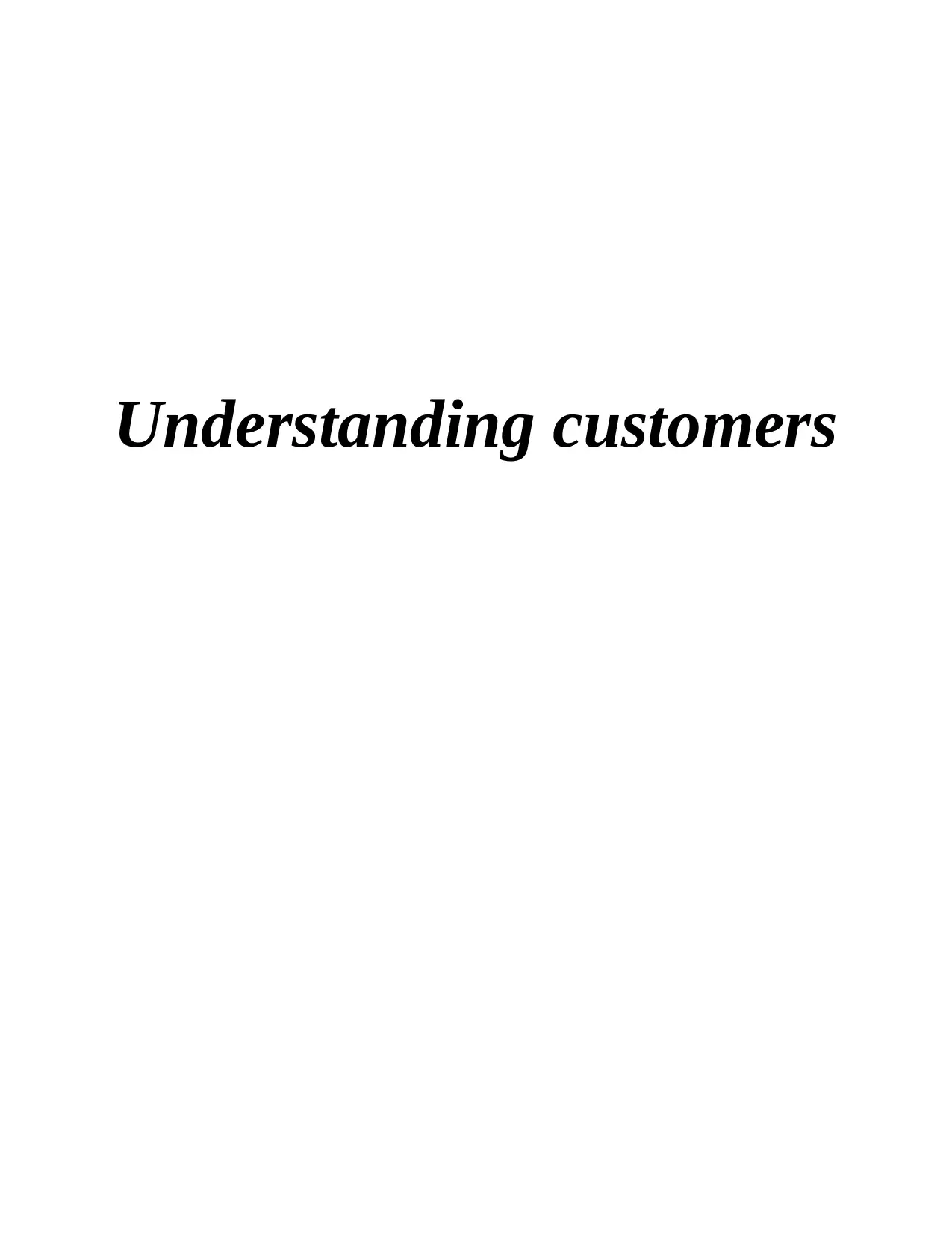
Understanding customers
Paraphrase This Document
Need a fresh take? Get an instant paraphrase of this document with our AI Paraphraser
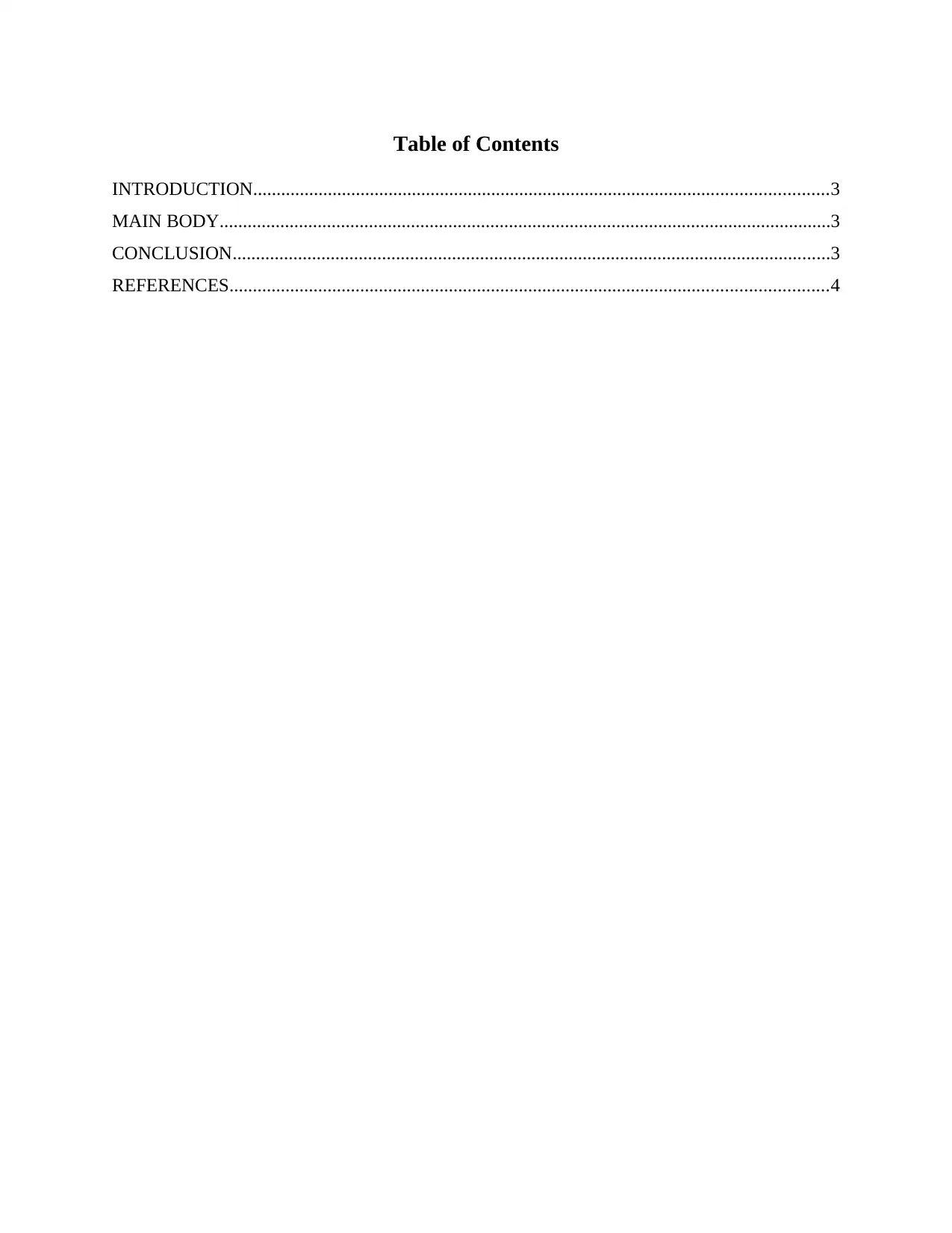
Table of Contents
INTRODUCTION...........................................................................................................................3
MAIN BODY...................................................................................................................................3
CONCLUSION................................................................................................................................3
REFERENCES................................................................................................................................4
INTRODUCTION...........................................................................................................................3
MAIN BODY...................................................................................................................................3
CONCLUSION................................................................................................................................3
REFERENCES................................................................................................................................4
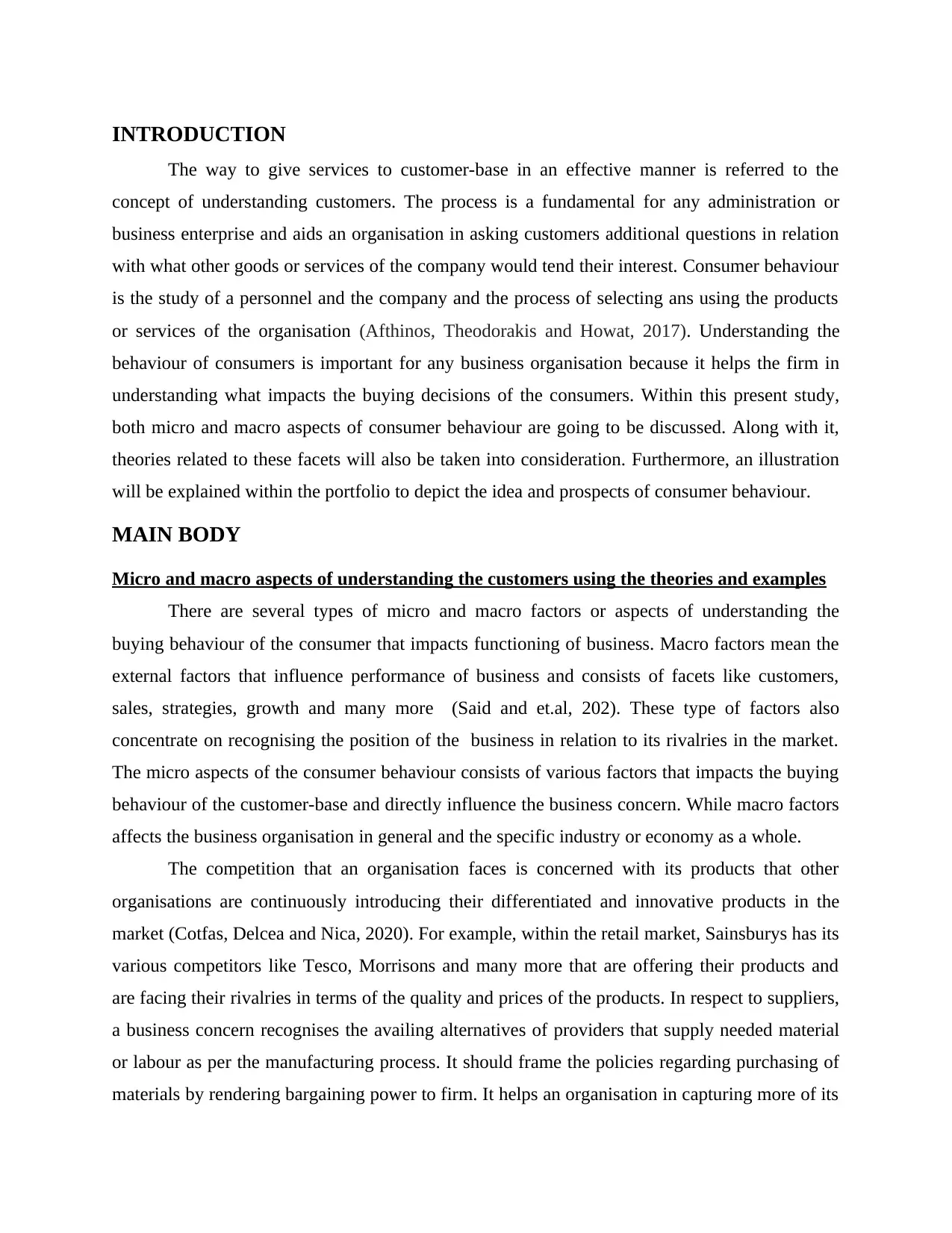
INTRODUCTION
The way to give services to customer-base in an effective manner is referred to the
concept of understanding customers. The process is a fundamental for any administration or
business enterprise and aids an organisation in asking customers additional questions in relation
with what other goods or services of the company would tend their interest. Consumer behaviour
is the study of a personnel and the company and the process of selecting ans using the products
or services of the organisation (Afthinos, Theodorakis and Howat, 2017). Understanding the
behaviour of consumers is important for any business organisation because it helps the firm in
understanding what impacts the buying decisions of the consumers. Within this present study,
both micro and macro aspects of consumer behaviour are going to be discussed. Along with it,
theories related to these facets will also be taken into consideration. Furthermore, an illustration
will be explained within the portfolio to depict the idea and prospects of consumer behaviour.
MAIN BODY
Micro and macro aspects of understanding the customers using the theories and examples
There are several types of micro and macro factors or aspects of understanding the
buying behaviour of the consumer that impacts functioning of business. Macro factors mean the
external factors that influence performance of business and consists of facets like customers,
sales, strategies, growth and many more (Said and et.al, 202). These type of factors also
concentrate on recognising the position of the business in relation to its rivalries in the market.
The micro aspects of the consumer behaviour consists of various factors that impacts the buying
behaviour of the customer-base and directly influence the business concern. While macro factors
affects the business organisation in general and the specific industry or economy as a whole.
The competition that an organisation faces is concerned with its products that other
organisations are continuously introducing their differentiated and innovative products in the
market (Cotfas, Delcea and Nica, 2020). For example, within the retail market, Sainsburys has its
various competitors like Tesco, Morrisons and many more that are offering their products and
are facing their rivalries in terms of the quality and prices of the products. In respect to suppliers,
a business concern recognises the availing alternatives of providers that supply needed material
or labour as per the manufacturing process. It should frame the policies regarding purchasing of
materials by rendering bargaining power to firm. It helps an organisation in capturing more of its
The way to give services to customer-base in an effective manner is referred to the
concept of understanding customers. The process is a fundamental for any administration or
business enterprise and aids an organisation in asking customers additional questions in relation
with what other goods or services of the company would tend their interest. Consumer behaviour
is the study of a personnel and the company and the process of selecting ans using the products
or services of the organisation (Afthinos, Theodorakis and Howat, 2017). Understanding the
behaviour of consumers is important for any business organisation because it helps the firm in
understanding what impacts the buying decisions of the consumers. Within this present study,
both micro and macro aspects of consumer behaviour are going to be discussed. Along with it,
theories related to these facets will also be taken into consideration. Furthermore, an illustration
will be explained within the portfolio to depict the idea and prospects of consumer behaviour.
MAIN BODY
Micro and macro aspects of understanding the customers using the theories and examples
There are several types of micro and macro factors or aspects of understanding the
buying behaviour of the consumer that impacts functioning of business. Macro factors mean the
external factors that influence performance of business and consists of facets like customers,
sales, strategies, growth and many more (Said and et.al, 202). These type of factors also
concentrate on recognising the position of the business in relation to its rivalries in the market.
The micro aspects of the consumer behaviour consists of various factors that impacts the buying
behaviour of the customer-base and directly influence the business concern. While macro factors
affects the business organisation in general and the specific industry or economy as a whole.
The competition that an organisation faces is concerned with its products that other
organisations are continuously introducing their differentiated and innovative products in the
market (Cotfas, Delcea and Nica, 2020). For example, within the retail market, Sainsburys has its
various competitors like Tesco, Morrisons and many more that are offering their products and
are facing their rivalries in terms of the quality and prices of the products. In respect to suppliers,
a business concern recognises the availing alternatives of providers that supply needed material
or labour as per the manufacturing process. It should frame the policies regarding purchasing of
materials by rendering bargaining power to firm. It helps an organisation in capturing more of its
⊘ This is a preview!⊘
Do you want full access?
Subscribe today to unlock all pages.

Trusted by 1+ million students worldwide
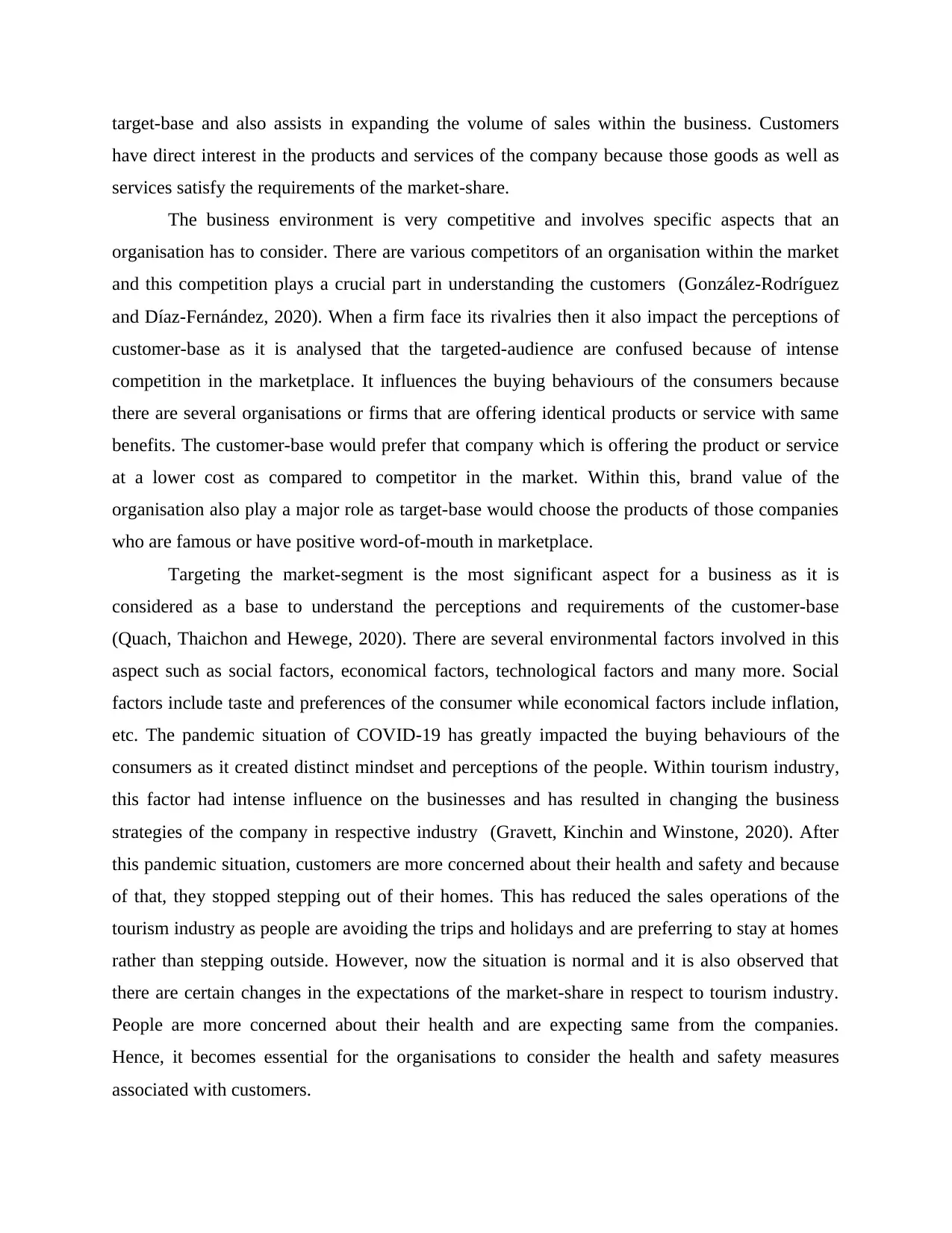
target-base and also assists in expanding the volume of sales within the business. Customers
have direct interest in the products and services of the company because those goods as well as
services satisfy the requirements of the market-share.
The business environment is very competitive and involves specific aspects that an
organisation has to consider. There are various competitors of an organisation within the market
and this competition plays a crucial part in understanding the customers (González‐Rodríguez
and Díaz‐Fernández, 2020). When a firm face its rivalries then it also impact the perceptions of
customer-base as it is analysed that the targeted-audience are confused because of intense
competition in the marketplace. It influences the buying behaviours of the consumers because
there are several organisations or firms that are offering identical products or service with same
benefits. The customer-base would prefer that company which is offering the product or service
at a lower cost as compared to competitor in the market. Within this, brand value of the
organisation also play a major role as target-base would choose the products of those companies
who are famous or have positive word-of-mouth in marketplace.
Targeting the market-segment is the most significant aspect for a business as it is
considered as a base to understand the perceptions and requirements of the customer-base
(Quach, Thaichon and Hewege, 2020). There are several environmental factors involved in this
aspect such as social factors, economical factors, technological factors and many more. Social
factors include taste and preferences of the consumer while economical factors include inflation,
etc. The pandemic situation of COVID-19 has greatly impacted the buying behaviours of the
consumers as it created distinct mindset and perceptions of the people. Within tourism industry,
this factor had intense influence on the businesses and has resulted in changing the business
strategies of the company in respective industry (Gravett, Kinchin and Winstone, 2020). After
this pandemic situation, customers are more concerned about their health and safety and because
of that, they stopped stepping out of their homes. This has reduced the sales operations of the
tourism industry as people are avoiding the trips and holidays and are preferring to stay at homes
rather than stepping outside. However, now the situation is normal and it is also observed that
there are certain changes in the expectations of the market-share in respect to tourism industry.
People are more concerned about their health and are expecting same from the companies.
Hence, it becomes essential for the organisations to consider the health and safety measures
associated with customers.
have direct interest in the products and services of the company because those goods as well as
services satisfy the requirements of the market-share.
The business environment is very competitive and involves specific aspects that an
organisation has to consider. There are various competitors of an organisation within the market
and this competition plays a crucial part in understanding the customers (González‐Rodríguez
and Díaz‐Fernández, 2020). When a firm face its rivalries then it also impact the perceptions of
customer-base as it is analysed that the targeted-audience are confused because of intense
competition in the marketplace. It influences the buying behaviours of the consumers because
there are several organisations or firms that are offering identical products or service with same
benefits. The customer-base would prefer that company which is offering the product or service
at a lower cost as compared to competitor in the market. Within this, brand value of the
organisation also play a major role as target-base would choose the products of those companies
who are famous or have positive word-of-mouth in marketplace.
Targeting the market-segment is the most significant aspect for a business as it is
considered as a base to understand the perceptions and requirements of the customer-base
(Quach, Thaichon and Hewege, 2020). There are several environmental factors involved in this
aspect such as social factors, economical factors, technological factors and many more. Social
factors include taste and preferences of the consumer while economical factors include inflation,
etc. The pandemic situation of COVID-19 has greatly impacted the buying behaviours of the
consumers as it created distinct mindset and perceptions of the people. Within tourism industry,
this factor had intense influence on the businesses and has resulted in changing the business
strategies of the company in respective industry (Gravett, Kinchin and Winstone, 2020). After
this pandemic situation, customers are more concerned about their health and safety and because
of that, they stopped stepping out of their homes. This has reduced the sales operations of the
tourism industry as people are avoiding the trips and holidays and are preferring to stay at homes
rather than stepping outside. However, now the situation is normal and it is also observed that
there are certain changes in the expectations of the market-share in respect to tourism industry.
People are more concerned about their health and are expecting same from the companies.
Hence, it becomes essential for the organisations to consider the health and safety measures
associated with customers.
Paraphrase This Document
Need a fresh take? Get an instant paraphrase of this document with our AI Paraphraser
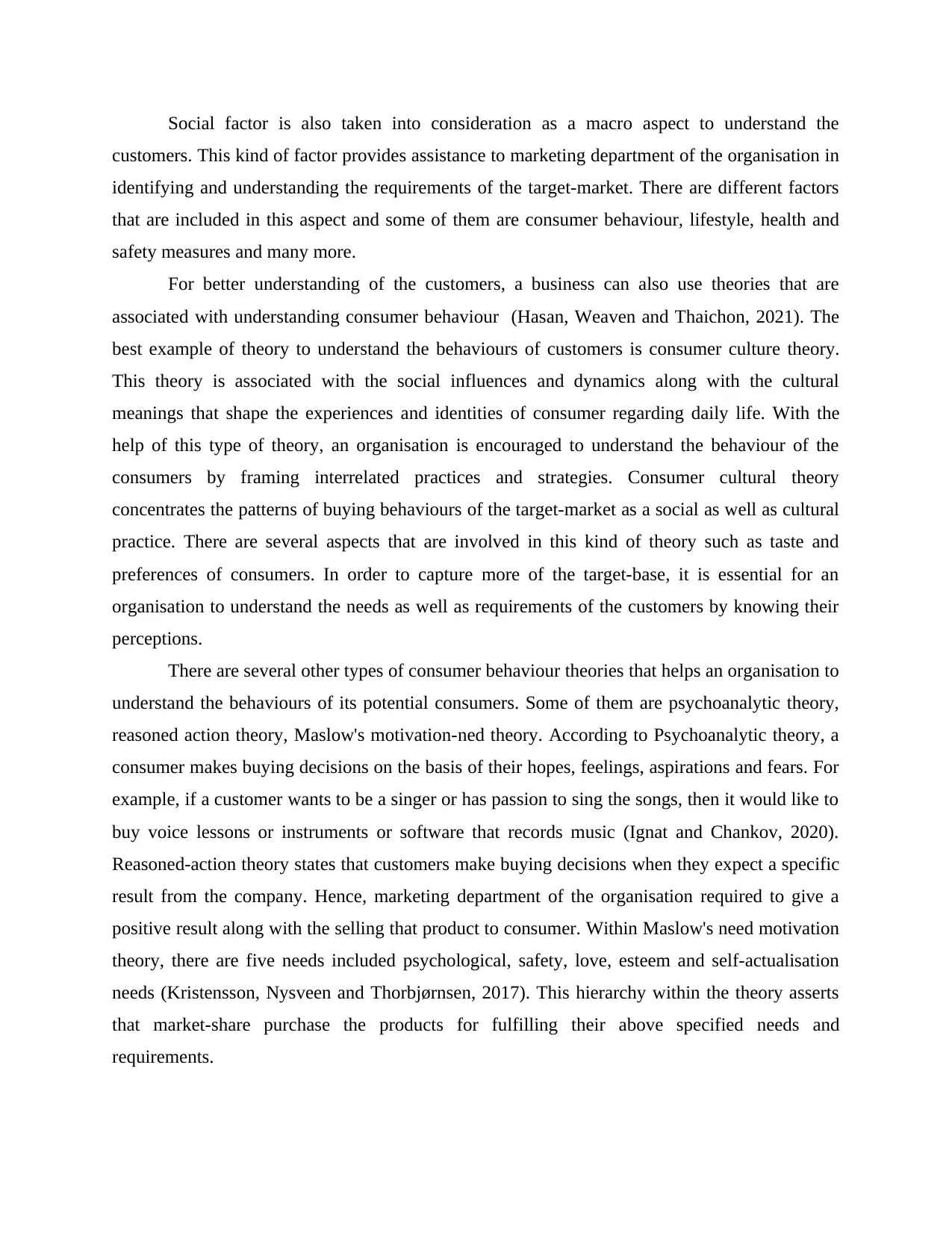
Social factor is also taken into consideration as a macro aspect to understand the
customers. This kind of factor provides assistance to marketing department of the organisation in
identifying and understanding the requirements of the target-market. There are different factors
that are included in this aspect and some of them are consumer behaviour, lifestyle, health and
safety measures and many more.
For better understanding of the customers, a business can also use theories that are
associated with understanding consumer behaviour (Hasan, Weaven and Thaichon, 2021). The
best example of theory to understand the behaviours of customers is consumer culture theory.
This theory is associated with the social influences and dynamics along with the cultural
meanings that shape the experiences and identities of consumer regarding daily life. With the
help of this type of theory, an organisation is encouraged to understand the behaviour of the
consumers by framing interrelated practices and strategies. Consumer cultural theory
concentrates the patterns of buying behaviours of the target-market as a social as well as cultural
practice. There are several aspects that are involved in this kind of theory such as taste and
preferences of consumers. In order to capture more of the target-base, it is essential for an
organisation to understand the needs as well as requirements of the customers by knowing their
perceptions.
There are several other types of consumer behaviour theories that helps an organisation to
understand the behaviours of its potential consumers. Some of them are psychoanalytic theory,
reasoned action theory, Maslow's motivation-ned theory. According to Psychoanalytic theory, a
consumer makes buying decisions on the basis of their hopes, feelings, aspirations and fears. For
example, if a customer wants to be a singer or has passion to sing the songs, then it would like to
buy voice lessons or instruments or software that records music (Ignat and Chankov, 2020).
Reasoned-action theory states that customers make buying decisions when they expect a specific
result from the company. Hence, marketing department of the organisation required to give a
positive result along with the selling that product to consumer. Within Maslow's need motivation
theory, there are five needs included psychological, safety, love, esteem and self-actualisation
needs (Kristensson, Nysveen and Thorbjørnsen, 2017). This hierarchy within the theory asserts
that market-share purchase the products for fulfilling their above specified needs and
requirements.
customers. This kind of factor provides assistance to marketing department of the organisation in
identifying and understanding the requirements of the target-market. There are different factors
that are included in this aspect and some of them are consumer behaviour, lifestyle, health and
safety measures and many more.
For better understanding of the customers, a business can also use theories that are
associated with understanding consumer behaviour (Hasan, Weaven and Thaichon, 2021). The
best example of theory to understand the behaviours of customers is consumer culture theory.
This theory is associated with the social influences and dynamics along with the cultural
meanings that shape the experiences and identities of consumer regarding daily life. With the
help of this type of theory, an organisation is encouraged to understand the behaviour of the
consumers by framing interrelated practices and strategies. Consumer cultural theory
concentrates the patterns of buying behaviours of the target-market as a social as well as cultural
practice. There are several aspects that are involved in this kind of theory such as taste and
preferences of consumers. In order to capture more of the target-base, it is essential for an
organisation to understand the needs as well as requirements of the customers by knowing their
perceptions.
There are several other types of consumer behaviour theories that helps an organisation to
understand the behaviours of its potential consumers. Some of them are psychoanalytic theory,
reasoned action theory, Maslow's motivation-ned theory. According to Psychoanalytic theory, a
consumer makes buying decisions on the basis of their hopes, feelings, aspirations and fears. For
example, if a customer wants to be a singer or has passion to sing the songs, then it would like to
buy voice lessons or instruments or software that records music (Ignat and Chankov, 2020).
Reasoned-action theory states that customers make buying decisions when they expect a specific
result from the company. Hence, marketing department of the organisation required to give a
positive result along with the selling that product to consumer. Within Maslow's need motivation
theory, there are five needs included psychological, safety, love, esteem and self-actualisation
needs (Kristensson, Nysveen and Thorbjørnsen, 2017). This hierarchy within the theory asserts
that market-share purchase the products for fulfilling their above specified needs and
requirements.
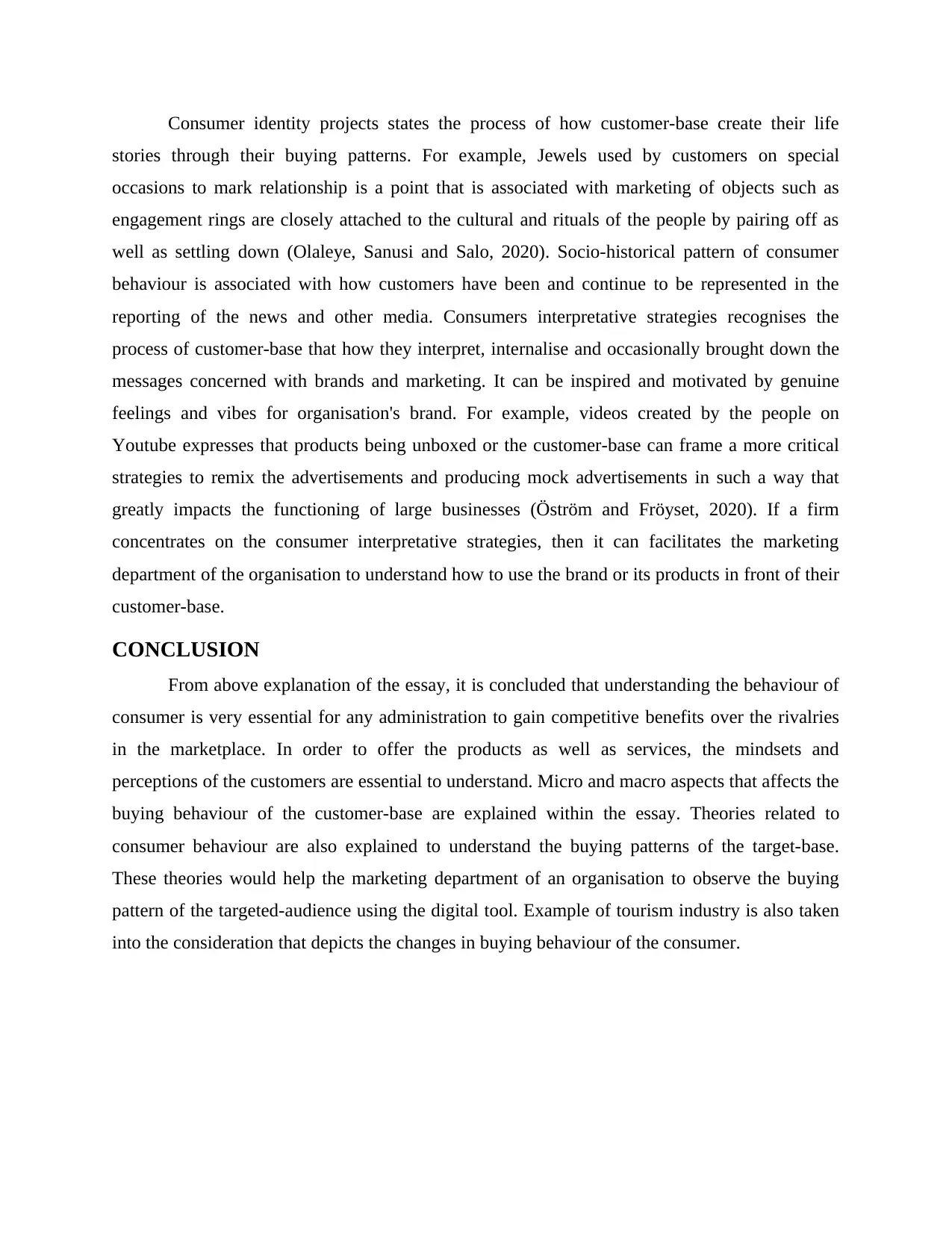
Consumer identity projects states the process of how customer-base create their life
stories through their buying patterns. For example, Jewels used by customers on special
occasions to mark relationship is a point that is associated with marketing of objects such as
engagement rings are closely attached to the cultural and rituals of the people by pairing off as
well as settling down (Olaleye, Sanusi and Salo, 2020). Socio-historical pattern of consumer
behaviour is associated with how customers have been and continue to be represented in the
reporting of the news and other media. Consumers interpretative strategies recognises the
process of customer-base that how they interpret, internalise and occasionally brought down the
messages concerned with brands and marketing. It can be inspired and motivated by genuine
feelings and vibes for organisation's brand. For example, videos created by the people on
Youtube expresses that products being unboxed or the customer-base can frame a more critical
strategies to remix the advertisements and producing mock advertisements in such a way that
greatly impacts the functioning of large businesses (Öström and Fröyset, 2020). If a firm
concentrates on the consumer interpretative strategies, then it can facilitates the marketing
department of the organisation to understand how to use the brand or its products in front of their
customer-base.
CONCLUSION
From above explanation of the essay, it is concluded that understanding the behaviour of
consumer is very essential for any administration to gain competitive benefits over the rivalries
in the marketplace. In order to offer the products as well as services, the mindsets and
perceptions of the customers are essential to understand. Micro and macro aspects that affects the
buying behaviour of the customer-base are explained within the essay. Theories related to
consumer behaviour are also explained to understand the buying patterns of the target-base.
These theories would help the marketing department of an organisation to observe the buying
pattern of the targeted-audience using the digital tool. Example of tourism industry is also taken
into the consideration that depicts the changes in buying behaviour of the consumer.
stories through their buying patterns. For example, Jewels used by customers on special
occasions to mark relationship is a point that is associated with marketing of objects such as
engagement rings are closely attached to the cultural and rituals of the people by pairing off as
well as settling down (Olaleye, Sanusi and Salo, 2020). Socio-historical pattern of consumer
behaviour is associated with how customers have been and continue to be represented in the
reporting of the news and other media. Consumers interpretative strategies recognises the
process of customer-base that how they interpret, internalise and occasionally brought down the
messages concerned with brands and marketing. It can be inspired and motivated by genuine
feelings and vibes for organisation's brand. For example, videos created by the people on
Youtube expresses that products being unboxed or the customer-base can frame a more critical
strategies to remix the advertisements and producing mock advertisements in such a way that
greatly impacts the functioning of large businesses (Öström and Fröyset, 2020). If a firm
concentrates on the consumer interpretative strategies, then it can facilitates the marketing
department of the organisation to understand how to use the brand or its products in front of their
customer-base.
CONCLUSION
From above explanation of the essay, it is concluded that understanding the behaviour of
consumer is very essential for any administration to gain competitive benefits over the rivalries
in the marketplace. In order to offer the products as well as services, the mindsets and
perceptions of the customers are essential to understand. Micro and macro aspects that affects the
buying behaviour of the customer-base are explained within the essay. Theories related to
consumer behaviour are also explained to understand the buying patterns of the target-base.
These theories would help the marketing department of an organisation to observe the buying
pattern of the targeted-audience using the digital tool. Example of tourism industry is also taken
into the consideration that depicts the changes in buying behaviour of the consumer.
⊘ This is a preview!⊘
Do you want full access?
Subscribe today to unlock all pages.

Trusted by 1+ million students worldwide
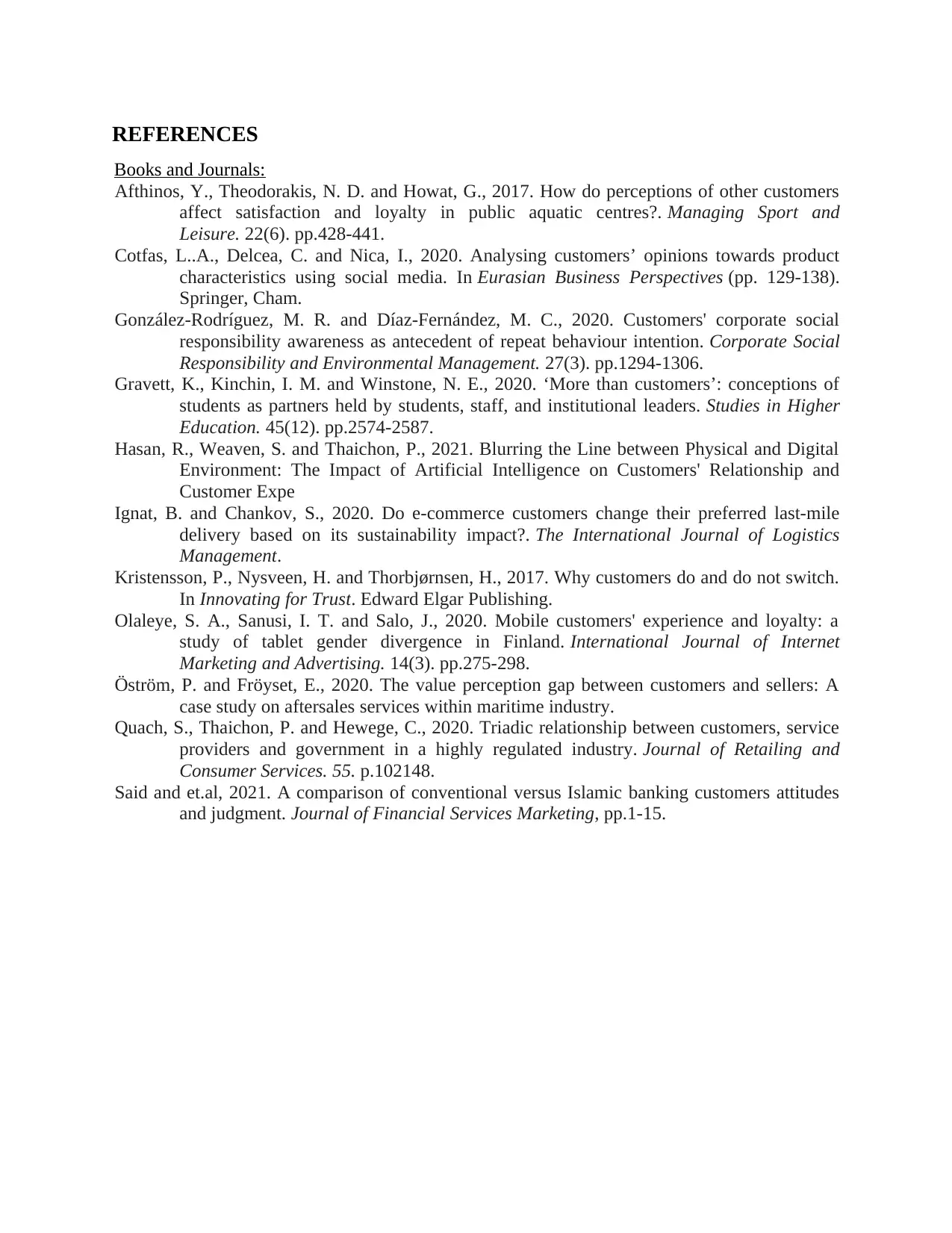
REFERENCES
Books and Journals:
Afthinos, Y., Theodorakis, N. D. and Howat, G., 2017. How do perceptions of other customers
affect satisfaction and loyalty in public aquatic centres?. Managing Sport and
Leisure. 22(6). pp.428-441.
Cotfas, L..A., Delcea, C. and Nica, I., 2020. Analysing customers’ opinions towards product
characteristics using social media. In Eurasian Business Perspectives (pp. 129-138).
Springer, Cham.
González‐Rodríguez, M. R. and Díaz‐Fernández, M. C., 2020. Customers' corporate social
responsibility awareness as antecedent of repeat behaviour intention. Corporate Social
Responsibility and Environmental Management. 27(3). pp.1294-1306.
Gravett, K., Kinchin, I. M. and Winstone, N. E., 2020. ‘More than customers’: conceptions of
students as partners held by students, staff, and institutional leaders. Studies in Higher
Education. 45(12). pp.2574-2587.
Hasan, R., Weaven, S. and Thaichon, P., 2021. Blurring the Line between Physical and Digital
Environment: The Impact of Artificial Intelligence on Customers' Relationship and
Customer Expe
Ignat, B. and Chankov, S., 2020. Do e-commerce customers change their preferred last-mile
delivery based on its sustainability impact?. The International Journal of Logistics
Management.
Kristensson, P., Nysveen, H. and Thorbjørnsen, H., 2017. Why customers do and do not switch.
In Innovating for Trust. Edward Elgar Publishing.
Olaleye, S. A., Sanusi, I. T. and Salo, J., 2020. Mobile customers' experience and loyalty: a
study of tablet gender divergence in Finland. International Journal of Internet
Marketing and Advertising. 14(3). pp.275-298.
Öström, P. and Fröyset, E., 2020. The value perception gap between customers and sellers: A
case study on aftersales services within maritime industry.
Quach, S., Thaichon, P. and Hewege, C., 2020. Triadic relationship between customers, service
providers and government in a highly regulated industry. Journal of Retailing and
Consumer Services. 55. p.102148.
Said and et.al, 2021. A comparison of conventional versus Islamic banking customers attitudes
and judgment. Journal of Financial Services Marketing, pp.1-15.
Books and Journals:
Afthinos, Y., Theodorakis, N. D. and Howat, G., 2017. How do perceptions of other customers
affect satisfaction and loyalty in public aquatic centres?. Managing Sport and
Leisure. 22(6). pp.428-441.
Cotfas, L..A., Delcea, C. and Nica, I., 2020. Analysing customers’ opinions towards product
characteristics using social media. In Eurasian Business Perspectives (pp. 129-138).
Springer, Cham.
González‐Rodríguez, M. R. and Díaz‐Fernández, M. C., 2020. Customers' corporate social
responsibility awareness as antecedent of repeat behaviour intention. Corporate Social
Responsibility and Environmental Management. 27(3). pp.1294-1306.
Gravett, K., Kinchin, I. M. and Winstone, N. E., 2020. ‘More than customers’: conceptions of
students as partners held by students, staff, and institutional leaders. Studies in Higher
Education. 45(12). pp.2574-2587.
Hasan, R., Weaven, S. and Thaichon, P., 2021. Blurring the Line between Physical and Digital
Environment: The Impact of Artificial Intelligence on Customers' Relationship and
Customer Expe
Ignat, B. and Chankov, S., 2020. Do e-commerce customers change their preferred last-mile
delivery based on its sustainability impact?. The International Journal of Logistics
Management.
Kristensson, P., Nysveen, H. and Thorbjørnsen, H., 2017. Why customers do and do not switch.
In Innovating for Trust. Edward Elgar Publishing.
Olaleye, S. A., Sanusi, I. T. and Salo, J., 2020. Mobile customers' experience and loyalty: a
study of tablet gender divergence in Finland. International Journal of Internet
Marketing and Advertising. 14(3). pp.275-298.
Öström, P. and Fröyset, E., 2020. The value perception gap between customers and sellers: A
case study on aftersales services within maritime industry.
Quach, S., Thaichon, P. and Hewege, C., 2020. Triadic relationship between customers, service
providers and government in a highly regulated industry. Journal of Retailing and
Consumer Services. 55. p.102148.
Said and et.al, 2021. A comparison of conventional versus Islamic banking customers attitudes
and judgment. Journal of Financial Services Marketing, pp.1-15.
1 out of 7
Related Documents
Your All-in-One AI-Powered Toolkit for Academic Success.
+13062052269
info@desklib.com
Available 24*7 on WhatsApp / Email
![[object Object]](/_next/static/media/star-bottom.7253800d.svg)
Unlock your academic potential
Copyright © 2020–2025 A2Z Services. All Rights Reserved. Developed and managed by ZUCOL.

